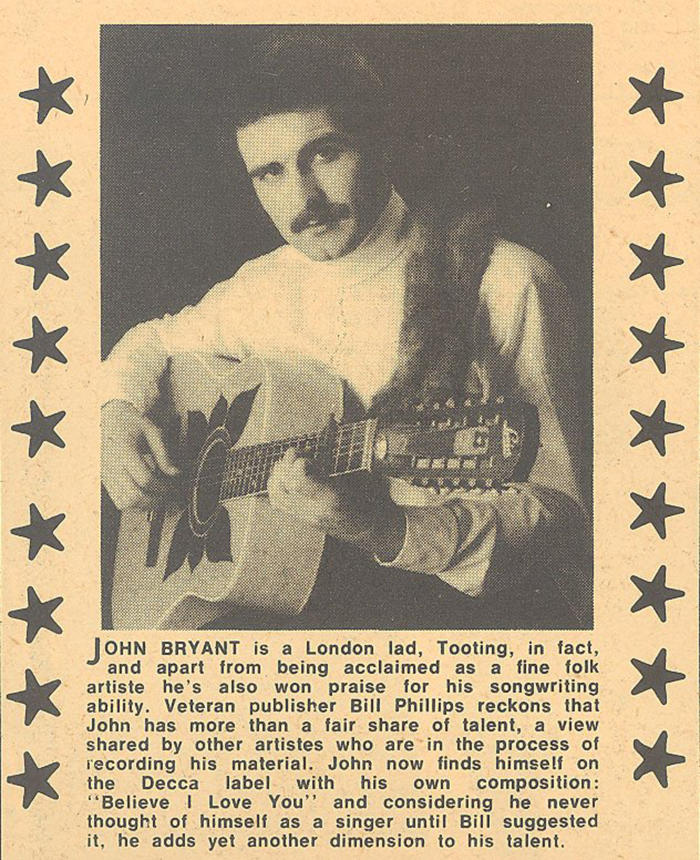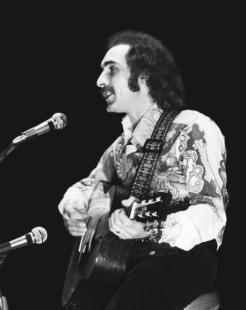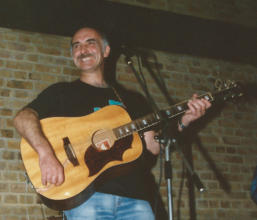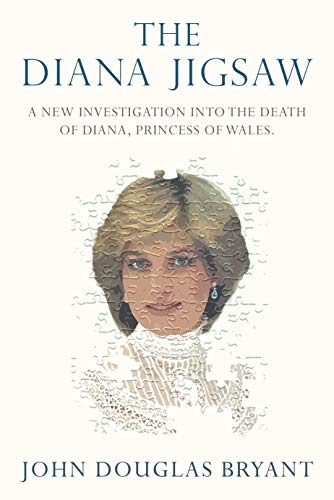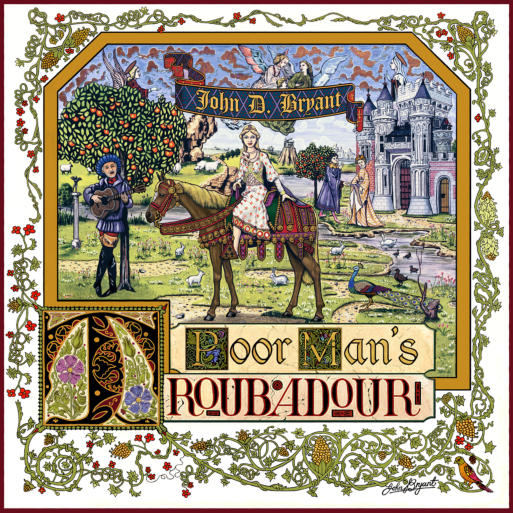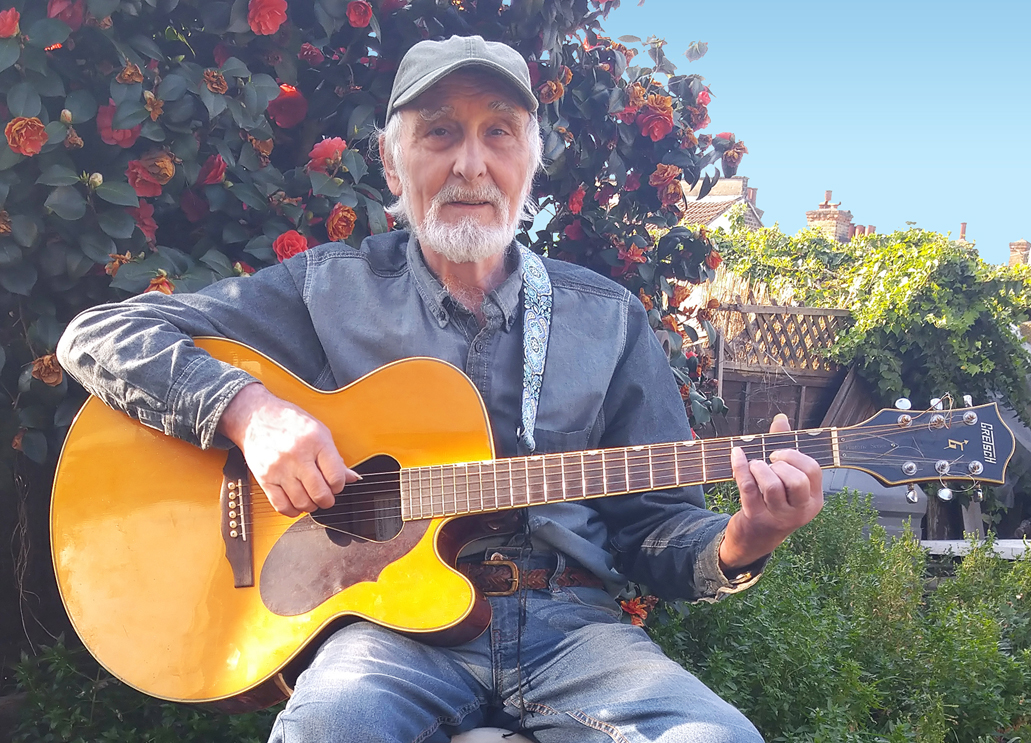By Jason Barnard
Songwriter John D Bryant’s story dates back to his 1965 Dylanesque debut “Tell Me What You See” with his subsequent material showcasing collaborations with Chris Spedding, Mike Moran, Tony Visconti and Mike Leander. Although his songs have been covered by The Shadows and Cliff Richard, it is his latest album “Poor Man’s Troubadour” that has put him back in the spotlight.
Hi John, can you tell me about your early years?
I was born in 1943 at number 16 Fishponds Road, Tooting. My father passed away from pneumonia when I was five years old, so I hardly knew him. He was an engineer by trade, but also played the drums in a dance band of the period. At nine years old, my mother and I moved in with George Woodcock, who later became my step-father.
I had played the recorder and violin at primary school, but with the advent of skiffle and rock and roll in the 1950s, the violin was ditched in favour of the guitar. Having passed the 11 Plus, I went to Bec Grammar School, Tooting from 1955 to 1960, when I was politely asked to leave. I burned my cap on the way out and started looking for a job.
I worked in an ad agency for 18 months as production junior and design assistant. I then went to Metal Box Company until 1969 and worked as a packaging designer and then head of the paper & board department. During that time, I played in several folk clubs.
So what were your first bands?
From July 1963 to 1965, I was a member of Tooting band ‘The Shifters’ with two Bec school mates and another friend. The Bec mates had been in a band with another Bec boy, Tony McPhee, later of Groundhogs fame. The Shifters was a basically a covers band playing Beatles, Everly Brothers, Searchers, Chuck Berry, Larry Williams, Elvis, Stones, etc. I started writing songs, some of which we recorded at R. G. Jones studio in Morden.
We played hundreds of gigs in those three years, including with the Barron Knights, Billy J. Kramer & the Dakotas, League of Gentlemen and the Zombies. We also regularly played clubs, US air bases and had residencies and regular gigs at several South London pubs.
We appeared on ITV’s ‘Ready, Steady, Win’, a talent contest for bands and spent a night in Chelmsford police cells for stealing three shillings and ninepence worth of petrol after a Wethersfield air base gig where they refused to let us buy petrol for the group van. The Shifters broke up in 1965 and I went solo.
Your debut single was ‘Tell Me What You See’ on Fontana. What led you to getting signed and were your influences at the time?
I signed a publishing deal with Macmelodies and KPM produced three singles – “Tell Me What You See”, “Somebody New” and “A Million Miles Away” in ’65, ’66 and ‘67. I did “Somebody New” on Five O’clock Club in January ’66 with my right leg in plaster due to compound fractures of tibia and fibula in a football match. I had been scouted for Chelsea as a goalkeeper, but that went by the board. My influences then were Bob Dylan, the Beatles, Chet Atkins, American blues artists and the Beach Boys.
You worked with Mike Leander on your 1968 single “I Bring The Sun”. It has a ‘psychedelic’ feel – was it influenced by Sgt Pepper?
Mike Leander was a great producer, but I think he was influenced by what was happening at the time e.g. psychedelic/West Coast. I was looking for a more Donovan or Dylan style but different. Some of the song was obviously influenced by Sgt. Pepper, but I would never compare it with that and it was definitely not drug-induced.
Did you play many live shows as a solo act?
My first solo gig was in April ’66 as support for the Small Faces at Streatham Ice Rink. I did quite a few colleges, The Rainbow, Queen Elizabeth Hall with Georges Moustaki, Cambridge Folk Festival, Stoneground Manchester with Leo Sayer in January ’74, several Marquee Club gigs, one with Focus and several at New Ash Green. I also had a residency at Smalls after-theatre restaurant in Brompton Road, alternating with the Dudley Moore Trio. At the 1984 Cambridge Folk Festival I was asked to introduce Alan Stivell and John D. Loudermilk, but a jobsworth security bloke who hadn’t read the script chucked me out before they were due to come on.
Guy Fletcher was my song plugger at KPM in the ‘60s and is still a friend. I sang on one of Alan Hawkshaw’s songs, wrote with Keith Mansfield and he arranged some of my songs. I was friends with John Kongos, recorded with him at his Tapestry studio, recorded two of his songs on Private Stock Records and played at Dingwall’s on what I think was his only gig. I wrote four songs with Terry Dempsey including “She’s A Gypsy” for Cliff. I also knew Bill Martin, Wayne Bickerton and other KPM and Heath Levy writers.
Who have you worked with?
Over the years, I worked with session musos: Mo Foster, Henry Spinetti, Chris Spedding, Ray Russell, Ray Cooper, B. J. Cole, Mike Moran, Clem Cattini and others. I worked with producers: David Mackay, Tony Visconti, Mike Leander, Peter Sames and Wayne Bickerton.
https://www.youtube.com/watch?v=KL1Lg6qAl0k
‘Dear Old Mrs Bell’ is a great track of yours recorded by The Shadows and a shift in sound being their first vocal single. Were you submitting publishing demos at the time – what led them to record it?
I had demoed the song for Bill Phillips at Charms Music and I can only think that he got it to the Shadows or Norrie Paramour. I was surprised when he told me they were recording it because it was their first vocal A-side. It was a true story about an old lady who lived near me in Tooting. I used to get odd bits of shopping for her.
What are your memories of recording your eponymous debut LP? The arrangements on tracks like ‘Daybreak’ work really well.
I signed a five-year deal with Polydor in 1970 and set up my own music publishing company. I remember spending several weeks at a friend’s flat in Sandgate, writing the songs and had a great time with Mike Moran discussing the arrangements. He wrote the string, brass and backing vocals arrangements. We recorded it at Lansdowne Studios.
Chris Spedding played that great electric guitar part on Daybreak. Lincoln Station was about a former girlfriend in Lincolnshire. Woodbine Annie was about a lady of the night who provided services for the sailors in Dover in exchange for cigarettes. The story was told to me by Fred, an ex-cop who refused to arrest her. Lester May’s Country Band was about a country band I was a member of for a short time.
I also played guitar and sang for a while in ‘Chanter’ an Irish folk band with Hughie Flint, Malcolm Rogers and Paul Gillieron.
You released ‘On The Dole’ under the Arthur’s Mother banner in 1971. Was this a solo track or a group effort?
I formed Arthur’s Mother with Arthur Kitchener and Mike Wedgewood, but Mike was asked to join Curved Air, and as we had been in the process of recording it, we initially kept the group name. We broke up and I can’t remember who played on ‘On The Dole’, but I think it was probably session guys in the end. Later, Polydor decided to release it under my name. We had a Power Play on Radio Luxembourg and the BBC was playing it a lot until they realised that the helmet referred to in the last verse was not the motorbike kind. They dropped it like the proverbial hot spud.
What are your recollections of writing and recording 1973’s ‘Peace Will Be Mine’? It’s a song that resonates with people to this day.
I wanted to write a song that said peace was not the exclusive property of the religious community. Polydor wanted to release it as a Christmas record and cut the verse that said, “Tear down your churches and your chapels, they own the earth on which we stand, but can they guarantee to find the key into the promised land”. That changed the whole message, but I still wanted it to sound like a hymn.
However, I loved the recording session and Andrew Pryce Jackman’s arrangement. The final mixing session was a nightmare, like mixing an orchestral work with choir, cathedral organ and my voice thrown in. I remember the problem we had cutting the master disk because it begins so quietly and built to an impressive crescendo.
I was touched when South African producer, Grahame Beggs produced the song, sung by Dennis East in 1986 and dedicated it to his wife Christine who had died that year.
I performed it live on ‘New Faces first series final’ in 1973. It was meant to be recorded live, but my microphone suddenly started moving across the floor and I had to stop and restart. Apparently, the Showaddywaddy guys who were also in the final thought it would be fun to pull the lead.
How did you get to record in Nashville and who did you work with?
I was fortunate enough to go to Nashville in 1974. The trip was made possible by my song, “Painter of the Sky” reaching the finals of the first American Song Festival in Saratoga Springs from 60,000 entries. It was performed beautifully by José Feliciano, but was beaten by a Kenny Loggins song.
I spent a few lovely evenings with José and his wife. Then Martin Grinham of Valentine Music Group and I flew down to Nashville. We were hosted by Marijohn Wilkin (One Day at a Time) and her husband, Clarence Selman (Jim Reeves’ ex-manager). They introduced me to some of the real country greats, including Johnny Cash and Waylon Jennings, and I played and sang on several sessions with legendary producer, ‘Cowboy’ Jack Clement. I don’t recall the artists, but the session guys were brilliant and I learned to read their music charts shorthand. I was also invited to become the first British member of the Nashville Songwriters’ Association.
You’ve mentioned that Cliff Richard recorded ‘She’s A Gypsy’, do you recall writing it?
I wrote the song with Terry Dempsey on a train. As I recall, I wrote most of the lyrics and Terry wrote most of the melody. I already had the idea and some of the words for a song I’d already been working on called “No More Gypsy Life For Me”.
You continued releasing singles into the late 70s.
Yes, in 1976, I signed a three-year deal with Private Stock Records, but the company closed in 1978. In 1977 my daughter, Daniella was born and I needed to buy a house, which meant I needed a steady income to get a mortgage. I went back to full-time freelance design work, mainly for a company in Edgware Road where I had desk space. This was during the era of huge house price inflation and gazumping, so it took three years to find and buy a house.
I kept writing songs, but felt I couldn’t commit to a traditional record company deal. I recorded a few singles under different names, helped to build two small recording studios and tried to promote a stage musical I had written in the early seventies with a friend, Peter Edwards.
‘No Strings’ was produced by David Mackay at his Factory studio. The song was inspired by a little back room in Tooting where I had some classical guitar lessons many, many, many years ago. Hence the fingerpicking solo parts.
How much did you collaborate with Tony Visconti and on what material?
Tony Visconti produced ‘Midnight Cowboy’ and ‘One of These Mornings’ in his Hammersmith studio for his Good Earth label via RCA. I used the name, ‘Buffalo’. He was brilliant to work with and a really nice guy to boot. He let me try mixing one of David Bowie tracks that he was having trouble with. It was a complex track and I doubt if my mix was used in the end. A very pleasant part of the recording sessions was the lunchtime gin and tonic breaks in his garden. I would have loved to have done more with him, but sadly, that didn’t happen.
What led you to leaving the music industry and what did you do afterwards?
In 1977, I was also producing some tracks for the very talented Brian Chatton at Polydor. As we were mixing the final track, the Polydor A&R guy told us that he had to find a punk band, so that was that. He didn’t even listen to the tracks. I think that really sealed it for me. Not only did I abhor punk music, I couldn’t believe the dismissive attitude. I recorded one more single, “Mr Tambourine Man” for Private Stock, produced by Alan Blakley of the Tremeloes and called it a day.
I was still writing and in 1979, I met the owner of a large print group in the Cannes Casino while at Midem. He asked if I could set up a design company for his printing group. I set up Ace of Arts in West Central Printers offices in Rathbone Place, but that was a disaster. West Central’s owner had lost many of their clients because the owner had lost the plot. He took out a gun at one lunch with a client and threatened to shoot himself. I was asked to try to get those clients back, which I did, but it was not a good situation and I left in 1981.
In 1981, I joined Roy Weavers to market NFL Videos in the UK. We produced and edited TV commercials. Wrote and produced “The Armchair Coach”, sponsored by USA Today newspaper. In 1982, I shared a design studio in New Bond Street and my clients included M&S, Tesco, Richard Ellis and Avon Cosmetics.
In 1985, I formed Cooper Bryant design & advertising consultancy and leased a floor in New Bond Street. We employed six other designers, a model maker and a secretary. Clients included M&S, Tesco, Avon cosmetics, Phonogram, Odyssey Studios, several estate agents, architects and property developers. I also produced radio and TV commercials.
One commission involved buying and restoring an ex-pirate radio ship, formerly Laser 558, and moving it to the Costa Del Sol to compete with Radio Gibraltar. One night the ship was raided by a group of thugs intent on stealing it. John and his partner responded by hiring a group of ex-SAS guys, who stormed the ship wearing balaclavas and brandishing serious weaponry. The ship was eventually impounded by the DTI when the anchor chain broke and it strayed into British waters.
In 1988, I and three others launched ‘Satellite Times’ magazine when the first Astra satellite went up. I was editor, designer and deputy MD. At the same time, I designed and formulated marketing and merchandising plans for theme parks in Marbella and Athens, neither of which were constructed. However, the magazine was so successful that Robert Maxwell, Asil Nadir, Richard Desmond and Conde Nast all made offers to buy it. Those offers could have made me very wealthy, but they were all scuppered by the non-executive Chairman, who was trying to con the shareholders into selling it to him. I resigned and went freelance again until 1992, when I was asked to work at the BRIT Performing Arts School in Croydon. During seven years there, my activities included teaching A-level music technology and grade 8 classical guitar.
In 1996, I worked with David Mackay and others on ‘Up With People’ stage show concepts, as well as writing three songs for their ‘World In Motion’ show. In 2000, I went to run the Philips design and print department in Croydon.
In 2004, I decided it was time for a career change. I worked for a couple of years with a film producer in Croydon, who turned out to be completely mad. She was flying off to a film festival and asked me to drive her car back to Croydon from Gatwick Airport. We were late setting off, but the producer decided to stop at a bank for cash and collect some papers from her home on the way. It seemed unlikely that she would make the plane, so she drove like a lunatic. I soon realised that it was not one of my better decisions. We sped along a narrow country road and approached a red traffic light. The waiting cars were in a single line, but she thought there was room on the inside lane and put her foot down. A few yards from the lights, she smashed into a huge block of concrete. A BMW on their outside was the only thing that stopped the car turning over. She drove away but had to stop in a lay-by after a few yards because the car was all over the road. Assisted by a helpful lorry driver, we changed the wheel and set off again for Gatwick. Now comes the really scary part! She was doing 80 in the outside lane with the radio on full blast and the car was vibrating like crazy and veering all over the road. Then, to cap it all, she fell asleep. I shook her awake and we eventually arrived at Gatwick.
I was convinced that my third or fourth heart attack was imminent. She grabbed her stuff and ran into the airport, leaving me to drive the wrecked car back to Croydon. I discovered that the wheel bearing and shock absorber had completely gone, but I somehow managed to get back in one piece. Soon after, I left Croydon having learned a little about filmmaking and a lot about stunt driving.
Meanwhile, in 2004, I was commissioned to write a score and songs for a feature film about the death of Diana, Princess of Wales. I was then asked to re-write the script as well. The producer was an ex-colleague at Satellite Times magazine and had an office at Pinewood Studios.
In 2006, I set up Bryant Whittle Ltd with Amanda Whittle, a colleague from the BRIT School to develop and produce concepts for film and TV. We raised all the investment for the Diana film, attached a distributor and Malcolm McDowell, but the producer managed to screw the deal up by trying to push the investor. We developed a few projects of our own, one of which suffered when the recession hit. We struggled on regardless and wrote a series of early-reader rhyming English books that were published in Malaysia and Singapore.
Can you tell me about your book ‘The Diana Jigsaw’.
After years working on that other Diana film, I realised that the book it was based on was full of unproven conspiracy theories and had no story. So, I spent more years conducting a proper forensic investigation of all the evidence. That included producing a time-lapse animation of Diana’s final journey and analysis of the post-mortem and blood testing procedures. I also discovered a serious conflict of interests that affected the British inquiry and, in turn, the official inquest, as well as evidence proving that the White Fiat Uno did not exist. It was one huge cover-up involving the French and British establishments.
“The Diana Jigsaw” was published at the end of 2019 by Lume Books. I am now planning a film of the same name, based on the investigation. Alice De Sousa of Galleon Films Ltd will produce and discussions with a director are ongoing. Meanwhile, I completed a seven-movement orchestral suite “Earth Chronicle” and realised that I should put together a new album of my unreleased recordings. The result is “The Poor Man’s Troubadour”, which is now available to download on the major streaming platforms.
Can you tell me about how you got involved writing the orchestration for the film “The Universe Chronicle”?
Some years ago, I started writing a symphony called “Earth Chronicle”, which tells the story of Earth from its creation to its possible demise. It was titled Universe Chronicle for a while, but I decided that the original title was more appropriate. It all sprang from a concept I now call ‘The Sargon Manuscript’, which is a warning that we risk killing our planet and subsequently, because everything in the universe is interconnected, the universe as a whole. I am a little way into the book.
Having studied the laws of thermodynamics, I decided that the Big Bang theory was impossible and that a theory I call the ‘Infinite Recycling Universe theory’ made more sense. In order to present the concept, I decided to compose a suite of orchestral compositions and tell the story with 3D CGI graphics and the music, plus a minimum of captioning.
When did you write the songs for your latest album “The Poor Man’s Troubadour”?
‘Troubadour’ began as a concept for an album while I was signed to Polydor. Prompted by my partner, Amanda, I recently digitally updated the artwork, title and some of the song lyrics.
‘You Were A Lady’ is recent, written for the Diana film. ‘Back to Mexico’ is a few years old, but re-recorded and some lyric changes. ‘I Was Solid Gone’ was written in the ‘80s and recorded at Ossie Byrnes’ studio. Was performed live. ‘Cold and Misty Hours’ is a new recording of a song that has seen a few versions since I wrote it in the late ‘70s. Performed live.
‘Poor Man’s Troubadour’ was ‘Troubadour’ until very recently. Re-recorded and new lyrics. Was performed live. ‘She’s A Gypsy’ was written in 1977/8. The album version is my recording, which was never released. ‘Who’s Fooling Who’ is about ten years old. Was performed live.
‘Lack of Enlightenment Blues’ I wrote while at the Cannes Film Festival in 2007. ‘Too Big for One’ is about 15 years old. ‘Matters of the Heart’ is about 5 years old.
I think the key tracks are ‘Back to Mexico’ and ‘Matters of the Heart’, but I like them all for different reasons.
What are your future plans?
I have just completed a first read through of my new novel “Delta Ball: Escape From Little Africa” and am waiting for Amanda’s first edit. It is a wildlife story and will have links to several songs. I will then hope to restart writing ‘The Sargon Manuscript’, write the narration for Earth Chronicle, and then write some more songs.
In the last few years, I have suffered three episodes of ventricular tachycardia and have asthma, COPD and arthritis. Naturally, I am in lockdown, but am using the time to do some writing and plan my next album.
NB: I used to have many more gigs, reviews, programmes, etc, but a huge old ash tree decided to fall on my garden studio where all of that stuff, along with master and demo tapes were kept. Everything was smashed to pieces and drenched.
Thanks so much John, it’s been brilliant to talk to you and hear your story. More information can be found at: johndbryant.com

